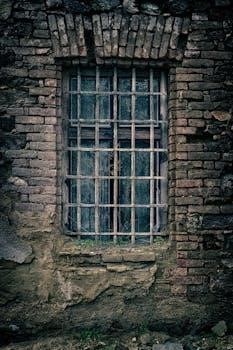Story Overview
The tale centers on three pigs who leave their mother to build their own homes. Each pig chooses a different material for construction, leading to varying levels of security against a hungry wolf.
Classic Narrative
The narrative unfolds with the three pigs venturing out to establish their own residences. The first pig constructs a house of straw, which is quick but fragile. The second pig chooses sticks, offering slightly more stability but still vulnerable. The third pig, demonstrating foresight, builds a sturdy house of bricks. The story then escalates as a big bad wolf tries to enter their homes. He easily blows down the straw and stick houses, forcing the first two pigs to seek refuge with the third. The wolf’s attempts to breach the brick house form the climax of the story, highlighting the importance of careful planning and strong foundations. The wolf then tries to enter through the chimney, but the pigs had a pot of boiling water waiting.
Moral of the Story
The core moral of “The Three Little Pigs” emphasizes the significance of hard work, diligence, and proper planning. The tale illustrates that shortcuts and hasty decisions can lead to vulnerability and danger, while investing time and effort in creating a solid foundation provides security and safety. The first two pigs, by choosing the easiest and fastest methods, suffer the consequences of flimsy houses, highlighting the importance of long-term thinking. The third pig’s prudent approach in building a brick house demonstrates that taking the time to do things right is always worthwhile, ultimately leading to success and protection. Therefore, the story subtly teaches the value of preparedness and the risks of laziness.
Characters
The story features two main groups⁚ the three little pigs, each with distinct personalities, and the antagonistic big bad wolf, who threatens their well-being and homes.
The Three Pigs
The first pig, often portrayed as carefree and lazy, opts for a simple straw house. The second pig, slightly more industrious, constructs a house of sticks. The third pig, the most diligent and thoughtful of the three, chooses to build a sturdy house of bricks. These distinct choices reflect their individual approaches to life and their levels of preparedness. They represent a spectrum of attitudes toward safety and effort, which is a central theme of the narrative. Each pig’s dwelling becomes a reflection of their character and ultimately dictates their fate when confronted by the wolf. The contrast between their houses highlights the importance of planning and hard work.
The Big Bad Wolf
The wolf is the primary antagonist, embodying cunning and predatory behavior. He is driven by hunger and a desire to capture the pigs for a meal. His tactics involve both deception and brute force, as he first attempts to persuade the pigs to let him in their homes, and then resorts to huffing and puffing to blow their houses down. The wolf’s actions serve to highlight the vulnerability of the first two pigs’ choices and the ultimate strength of the third pig’s brick house. His character represents a challenge that the pigs must overcome, showcasing the need for protection and resilience against external threats. His presence drives the plot forward and is the main source of conflict in the story.

House Construction
The story details the building of three houses. The materials used are straw, sticks, and bricks. These choices highlight different levels of protection from the wolf.
Straw House
The first little pig, opting for speed and ease, constructs his house from straw. This choice reflects a lack of foresight, prioritizing immediate comfort over long-term safety and durability. The straw house, while quickly assembled, proves to be highly vulnerable. It is easily susceptible to external forces, as straw lacks the structural integrity to withstand any significant impact or pressure. This frailty makes it an easy target for the wolf’s destructive actions, demonstrating the consequences of poor planning and a lack of attention to necessary protective measures in a perilous environment. The house’s quick construction contrasts with its equally rapid destruction.
Stick House
The second little pig builds his house from sticks, a step up from straw, suggesting a slightly more considered approach. While sticks offer more resistance than straw, they still lack significant strength. The stick house shows a marginal improvement in structural stability, but it remains insufficient to withstand a determined attack. The sticks, though somewhat more durable than straw, are not adequately robust to provide true protection. This house demonstrates that a little extra effort is not always enough to ensure safety, indicating a need for a much more substantial material for construction in the face of potential danger.
Brick House
The third little pig, displaying foresight and diligence, chooses to build his house from bricks. This demonstrates a commitment to safety and long-term security. The brick house stands as a symbol of careful planning and hard work, providing a strong and sturdy shelter. Unlike the previous two houses, the brick house is impenetrable to the wolf’s forceful attempts. Its solid construction demonstrates the importance of choosing high-quality materials when facing potential threats. This substantial home offers complete safety, highlighting the value of preparation and a willingness to invest the time and effort needed for true security.

Wolf’s Actions
The wolf, driven by hunger, targets the pigs’ homes. He uses his breath to try and destroy them, demonstrating his malicious intent and strength. He is determined to catch the pigs.
Blowing Down Houses
The wolf’s primary tactic involves using his powerful breath to blow down the first two pigs’ houses. He approaches the straw house and, with a huff and a puff, easily destroys it, forcing the first pig to flee. The wolf then proceeds to the stick house, similarly using his breath to dismantle it and chase away the second pig. This action demonstrates the wolf’s aggressive and destructive nature. The ease with which the wolf dismantles these initial homes highlights the vulnerability of the materials chosen by the first two pigs, emphasizing the story’s lesson on planning and preparation. These events escalate the tension, leading to the final confrontation at the brick house.
Attempt to Enter Brick House
Frustrated by the brick house’s resilience, the wolf tries a different approach. Unable to blow it down, he attempts to enter through the chimney. This shows his persistence and unwillingness to give up on his goal to catch the pigs. The third pig, anticipating this move, cleverly prepares a pot of boiling water at the base of the chimney. As the wolf descends, he falls into the pot, facing a painful and unexpected end. This climactic scene highlights the importance of foresight and strategic planning, ultimately leading to the wolf’s defeat and the third pig’s safety. The brick house, therefore, stands as a symbol of secure planning.

PDF Resources
The story of the three little pigs is widely available in PDF format. These versions offer easy access for reading and sharing, often with illustrations that bring the tale to life.
Availability of PDF Versions
Numerous digital platforms offer the “Three Little Pigs” story as a PDF download. This accessibility allows for convenient reading on various devices, including computers, tablets, and smartphones. Many of these versions are free, making it easy to share the classic tale with children. Formats often include illustrations, which further enhance the storytelling experience. Educators and parents alike find these digital resources beneficial for both classroom and home use; The PDF format ensures that the story remains consistent across different viewing platforms, preserving the layout and text. This wide availability enables a global audience to enjoy the tale in a easily accessible format. Several sites also offer multi-language versions expanding its reach.
Sources for PDF Downloads
Several online sources provide PDF versions of “The Three Little Pigs.” Websites like Usborne offer the story as part of their First Stories Collection. Educational platforms frequently include this classic tale for early childhood learning. Digital libraries and ebook services, such as LitRes, also make the story available for download. Additionally, some personal blogs and educational resource sites offer free PDF versions. These diverse sources enable users to access the story from various providers. It is important to ensure that the downloads are from reputable sites to maintain quality and safety. Some websites offer different versions, including variations in illustrations and text adaptations. This allows users to select the version that best suits their needs.

Educational Value
This story teaches valuable lessons about planning, preparation, and the importance of hard work. It is also a great tool for early childhood education, fostering critical thinking and decision-making skills.
Lessons on Planning and Preparation
The narrative provides a clear example of how different levels of planning and preparation can lead to vastly different outcomes. The first two pigs, who prioritize speed and ease over durability, face the consequences of their poor choices when the wolf arrives. Their flimsy houses, built of straw and sticks respectively, are easily destroyed, highlighting the dangers of not considering potential threats. Conversely, the third pig’s meticulous planning and investment of time into building a sturdy brick house demonstrates the value of foresight and preparation. This contrast underscores the idea that taking the time to do something properly, even if it requires more effort initially, can pay off significantly in the long run, especially when facing challenges or adversity. The story encourages children to think ahead and consider the consequences of their choices.
Early Childhood Learning
The “Three Little Pigs” is a valuable tool for early childhood education, offering a simple yet effective way to teach young children about cause and effect. The story’s clear narrative and repetitive structure make it easy for young minds to follow. The distinct characters, the pig’s building choices, and the wolf’s actions illustrate the consequences of decisions. Children learn that poor planning leads to negative outcomes, while careful preparation can ensure safety and success. The story also introduces basic concepts like different materials and their properties, helping children understand why a brick house is more robust than one made of straw. The predictable sequence of events allows children to make predictions, enhancing their engagement and comprehension of the narrative. Furthermore, the story encourages critical thinking skills.
